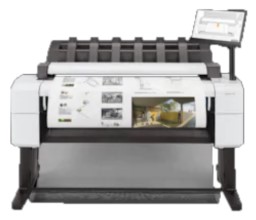Large format printers have become increasingly popular in various industries, as they offer the capability to print large and high-quality materials.
From printing banners and posters for advertising campaigns to producing detailed architectural and engineering designs, these devices play a crucial role in accomplishing diverse printing tasks. One question that often arises is whether a large format printer can print on regular paper.
The answer to this query is yes. Large format printers are designed to accommodate various types of media, including standard-sized paper. They are versatile machines that can easily adjust to different paper sizes and types. Users can benefit from the ability to print documents and images on a range of surfaces, which can increase their efficiency and productivity.
Though primarily utilized for bigger print jobs, these printers are also capable of handling smaller projects. This adaptability allows businesses and professionals to maximize their investments in large format printing technology while still meeting all their printing needs.
Types of Large Format Printers
Large format printers, also known as wide-format printers, typically support a maximum print roll width of between 18 and 100 inches. These printers are designed to handle large prints such as banners, posters, and other oversized visuals. There are different types of large format printers available in the market, each with its own set of features and capabilities.
Inkjet printers are a popular choice for large format printing as they offer high-quality, vivid color output. These printers use liquid ink that is sprayed onto the substrate, which can include materials such as paper, vinyl, canvas, and various textiles.
Depending on the specific model, inkjet large format printers can produce prints with impressive resolution and color accuracy, making them suitable for applications such as photography, fine art reproductions, and signage.
Laser printers use toner-based technology for large format printing. These printers utilize a high-powered laser beam to produce heat, fusing the toner to the substrate. Laser large format printers are known for their speed and precision, making them ideal for applications requiring high volume output, such as architectural plans, technical drawings, or business documents. Due to their toner-based technology, the color vibrancy and image quality may not be as high as that of inkjet printers, but they still can produce sharp, professional-looking prints.
All-in-one printers combine printing, scanning, and copying functions in one device. While all-in-one printers commonly cater to smaller print sizes, some models are designed to handle wide-format printing as well. These large format all-in-one printers provide versatility for users who need to print, scan and copy large documents or images.
Large format printing varies based on the specific needs of a project. Regardless of the type of large format printer being used, the printing process generally involves printing on a wide range of substrates, such as paper, vinyl, or canvas, to deliver the desired result. With the combination of modern technology and various printer options available, users can confidently achieve high-quality large format prints to meet their creative and professional needs.
Printer Features and Functions

Print Quality and Resolution
Large format printers are designed to produce high-quality prints for various applications such as posters, banners, and architectural plans. These printers often have a high print resolution, typically measured in dots per inch (dpi), which determines the level of detail and color accuracy in the final print. A wide-format printer with a high dpi will produce more precise, vibrant images, making it suitable for artists and professionals who require accurate color reproduction and sharp detail.
Print Speed
Print speed is a crucial factor to consider in large format printers, especially for businesses with high volume print jobs. Most wide-format printers have adjustable print speeds, allowing users to choose between fast output for drafts or slower speeds for higher-quality prints. It’s essential to balance print speed and quality based on the specific needs of the project at hand.
Paper Handling Capabilities
Large format printers are built to handle a variety of paper types, including plain paper, roll paper, and sheet paper. They often support borderless printing and allow for adjustments in paper margins to accommodate different media sizes. Furthermore, these printers typically have customizable paper trays and advanced paper handling features that enable users to print on different materials such as canvas, textiles, or vinyl.
Connectivity Options
Wide-format printers have multiple connectivity options, including USB ports, Ethernet connections, and wireless connections. Some models allow users to print directly from their smartphones, tablets, or other devices, making it easier to share and collaborate on large print jobs. Additionally, some large format printers come with built-in spectrophotometers, which help ensure accurate color calibration across multiple devices and over time.
In summary, large format printers offer various features for different applications, such as high print quality, adjustable print speeds, duplex printing, versatile paper handling capabilities, and multiple connectivity options. These attributes make them an invaluable tool for retailers, GIS professionals, artists, and others who need to print large documents with precise detail and color accuracy.
If you want more help deciding which technology is right for you, or want our expert opinion of which specific plotter is right for your particular needs, call us at (602) 224-9971 or contact us now, we’re happy to help!


